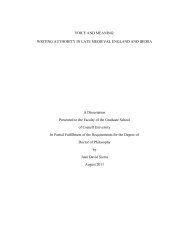Briana Anderson - Cornell University
Briana Anderson - Cornell University
Briana Anderson - Cornell University
You also want an ePaper? Increase the reach of your titles
YUMPU automatically turns print PDFs into web optimized ePapers that Google loves.
13<br />
In a related study, Lafferty and Goldsmith (1999) examined the effects of<br />
endorser and corporate credibility on consumers’ attitude toward the brand, attitude<br />
toward the ad, and purchase intentions. A 2 X 2 experiment (high versus low<br />
corporate credibility and high versus low endorser credibility) between subjects design<br />
was used. One hundred female students were shown 4 fictitious magazine<br />
advertisements and were asked to evaluate the credibility of the endorser using<br />
Ohanian’s (1990) endorser credibility scale and Newell’s’ (1993) corporate credibility<br />
scale. Additionally, participants indicated their attitudes toward the brand and<br />
advertisements as well as purchase intentions. The results of their experiment<br />
indicated that both types of credibility influence attitude toward the ad and the brand,<br />
but that corporate credibility alone has a significant influence on purchase intentions.<br />
Additionally, endorser credibility has a greater influence on attitude toward the ad<br />
while corporate credibility has a greater influence on attitude toward the brand and<br />
purchase intentions indicating that people look more to the endorser credibility for<br />
judgments about the ad and corporate credibility for judgments about the brand. In<br />
this study, the effects of endorser and corporate credibility were independent and did<br />
not interact.<br />
Finally, Lafferty et al. (2002) propose a theory of the combined influence of<br />
corporate and endorser credibility, shown in Figure 1.

















